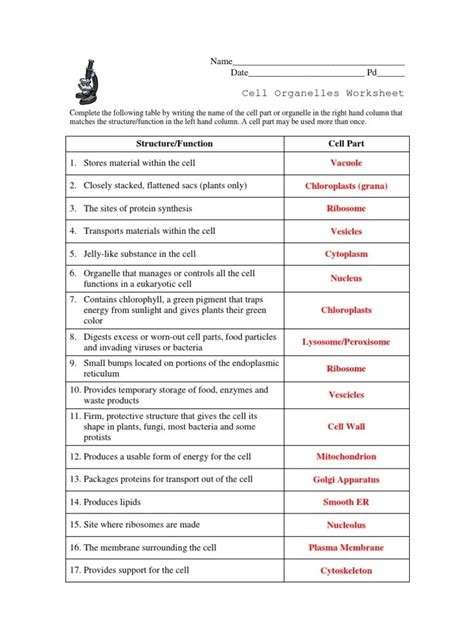Introduction

This answer key provides comprehensive solutions to the topic list for Unit Two: Cell Energy. It covers all the key concepts, processes, and mechanisms related to cellular energy metabolism, empowering students to grasp the intricacies of this essential biological process.
1. Cellular Respiration Overview
-
a. Define cellular respiration.
Answer: Cellular respiration is a complex set of metabolic reactions that occur within cells to convert biochemical energy from nutrients into adenosine triphosphate (ATP), the primary energy currency of cells. -
b. Name the four main stages of cellular respiration.
Answer: 1. Glycolysis; 2. Pyruvate oxidation; 3. Citric acid cycle; 4. Oxidative phosphorylation -
c. Which molecule is the final electron acceptor in aerobic cellular respiration?
Answer: Oxygen
2. Glycolysis
-
a. What is the net energy yield of glycolysis?
Answer: 2 ATP molecules -
b. Describe the role of NAD+ in glycolysis.
Answer: NAD+ accepts electrons from glucose molecules to form NADH, which is used later in cellular respiration to generate ATP. -
c. What is the significance of pyruvate?
Answer: Pyruvate is the end product of glycolysis. It can enter the citric acid cycle or be converted to lactate or ethanol in anaerobic conditions.
3. Pyruvate Oxidation and the Citric Acid Cycle
-
a. Explain the process of pyruvate oxidation.
Answer: Pyruvate is converted to acetyl-CoA, which enters the citric acid cycle. -
b. What is the purpose of the citric acid cycle?
Answer: To oxidize acetyl-CoA and generate electron carriers (NADH and FADH2) and ATP. -
c. How many ATP molecules are produced during one turn of the citric acid cycle?
Answer: 3 ATP molecules
4. Oxidative Phosphorylation
-
a. Describe the structure of the electron transport chain.
Answer: A series of protein complexes embedded in the inner mitochondrial membrane. -
b. What is the role of ATP synthase in oxidative phosphorylation?
Answer: To use the proton gradient created by the electron transport chain to produce ATP. -
c. What is the overall ATP yield of oxidative phosphorylation?
Answer: Up to 32 ATP molecules
5. Anaerobic Respiration
-
a. Define anaerobic respiration.
Answer: A form of cellular respiration that does not require oxygen. -
b. Name the two main types of anaerobic respiration.
Answer: Lactic acid fermentation and alcoholic fermentation -
c. Why is lactic acid fermentation inefficient?
Answer: It produces only 2 ATP molecules per glucose molecule.
6. ATP Production and Cell Function
-
a. How is ATP used in cells?
Answer: To power cellular processes such as protein synthesis, muscle contraction, and nerve impulse transmission. -
b. Estimate the number of ATP molecules hydrolyzed by a human cell daily.
Answer: Approximately 10^22 ATP molecules -
c. Discuss the role of ATP in maintaining homeostasis.
Answer: ATP provides energy to counteract disruptive forces and maintain a stable internal environment within cells.
7. Common Mistakes to Avoid
- a. Do not confuse glycolysis with the citric acid cycle.
- b. Remember that oxidative phosphorylation occurs in the inner mitochondrial membrane.
- c. Understand that anaerobic respiration produces significantly less ATP than aerobic respiration.
FAQs
-
What is the difference between aerobic and anaerobic cellular respiration?
Aerobic respiration requires oxygen while anaerobic respiration does not.
-
Why is ATP so important to cells?
ATP is used as the energy currency for cellular processes, powering a wide range of biological activities.
-
How do cells control the rate of cellular respiration?
Cells regulate cellular respiration through feedback mechanisms and metabolic pathways that respond to energy demands.
-
What are the implications of mitochondrial dysfunction?
Mitochondrial dysfunction can disrupt cellular energy production and lead to various diseases and disorders.
-
How can lifestyle factors influence cellular energy metabolism?
Exercise and diet can impact mitochondrial function and overall energy production.
-
What are potential applications of cellular energy research?
Research in this field could lead to advancements in bioenergetics, drug development, and disease treatment.
Conclusion
This answer key provides a comprehensive understanding of the key topics related to cellular energy metabolism, enabling students to critically analyze and solve problems related to this crucial biological process. By mastering the concepts outlined in this answer key, students can gain a solid foundation for further exploration and application of cell energy principles.
